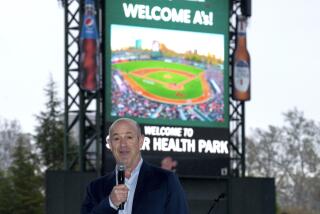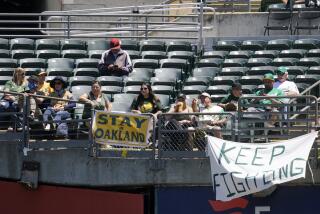Milwaukee’s Move a National Duty
- Share via
Acting Commissioner Bud Selig said Thursday it is with deep sadness that his Milwaukee Brewers are leaving the American League after 28 years but with great anticipation that Milwaukee is returning to the National League.
“We’re coming home,” he said.
The move of his Brewers from the AL Central to the NL Central was announced officially Thursday at a Milwaukee news conference, where Selig talked about the glory days of the Braves in Milwaukee and emphasized that this was only the first phase of a historic realignment.
“If this is the only thing that happens [in realignment] I’ll be very disappointed,” he said. “But I’m confident the next phase will involve a significant number of teams.”
For 1998, the Brewers are joining a six-team National League Central, the Detroit Tigers are moving from the American League East to the AL Central, and the Tampa Bay Devil Rays, originally assigned to the American League West, will begin play in the AL East.
The National League, including the Arizona Diamondbacks in the West, will have 16 teams and the American will have 14. Selig said that alignment was imperative to avoid the necessity of an interleague game every day in a 15-15 alignment and to reduce the number of two-game series.
The Kansas City Royals had first option on making the move from the American to the National but club executors declined, saying it would be unfair to prospective buyers to uproot the team when it is for sale.
The Brewers then agreed to become the first team this century to switch leagues. Selig called it a traumatic decision but cited the city’s National League roots, the overwhelming poll support of Milwaukee fans, the opportunity to develop geographic rivalries with the Chicago Cubs and St. Louis Cardinals, and the urging of fellow owners in a resolution from baseball’s realignment and expansion committee.
“I don’t want to make ourselves appear to be heroic, but somebody had to take this first step,” Selig said. “I believe it will work out so well, that it will prove to be so right and so logical, that the second [phase] will come much easier.”
The voting deadline for the second phase--with only majority approval required but any club switching leagues or divisions having veto rights--is Oct. 31, 1998. How Selig and the committee hope to get “a significant number” of teams to switch leagues when they couldn’t do it this time is unclear.
Committee chairman John Harrington, president of the Boston Red Sox, said in Milwaukee that an important consideration in relation to realignment will be negotiations with the players’ union involving extension of interleague play beyond 1998 and the future of the designated hitter. The owners hope to phase it out in return for the addition of a 26th player on each roster.
The union, however, opposes elimination of the designated hitter and any realignment that leaves the West Coast without an American League presence. Almost all of the committee’s realignment scenarios continue to call for the Angels, Seattle Mariners and Oakland A’s to switch to the National League.
More to Read
Go beyond the scoreboard
Get the latest on L.A.'s teams in the daily Sports Report newsletter.
You may occasionally receive promotional content from the Los Angeles Times.










